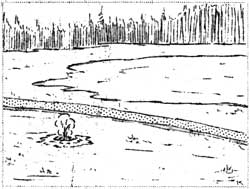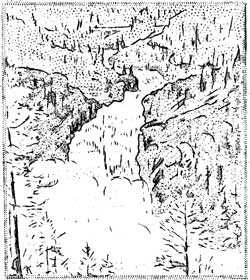THE BIRTH OF A HOT SPRING
by Ranger Naturalist Sweetman
Geysers eventually become either quiescent or extinct. Their
eruptions may cease and they become pools of boiling water or steaming
vents. They may become mere mounds, to all appearances cold and dead.
The Giantess and the Beehive as well as the Lioness and the Big Cub
geysers are not as active as they once were and their activity may cease
altogether at some distant day. The Excelsior and the Splendid geysers
have already ceased their play. The White Pyramid Cone and the cones
about Old Faithful are but the cold monuments of what was once
interesting thermal activity, although on cool mornings a light steam
vapor may be distinguished at times.
Geysers become inactive in at least five different ways. First, the
deposition of silica may build up the cone to such a height that the
volume of water in the tube is increased considerably. This increase is
sufficient to overcome the pressure of the steam generated at depth in
the geyser tube and no eruption can take place. Second, an additional
source of cold water may be tapped thus cooling the water in the geyser
tube sufficiently to keep the water from attaining enough heat to cause
an eruption. Third, the water which is supplying the geyser may find
another outlet, causing the geyser "plumbing" to become dry. Fourth, the
silica may seal the geyser tube and prevent further activity. Fifth,
leaks may occur in the steam chamber allowing the steam to escape before
it builds up pressure sufficient to cause an eruption.
Although geysers and hot springs are becoming dormant or ceasing
their activity altogether, frequently there are new springs breaking
through the earth's crust, some of them later to become active geysers.
The Daisy Geyser, one of Yellowstone's most beautiful geysers, is a
current example, it having become active about 1896 when the Splendid
Geyser became too dilatory. While stationed at Old Faithful during the
summer of 1936, it was the privilege of the writer to watch the birth of
a new hot spring in Black Sand Basin.
The scene of this new activity is just northwest of Sunset Lake, a
few feet to the right of the walk between this lake and Rainbow Pool. As
we visited this ares, a point of interest on the famous Geyser Chasing
Caravan, there was no sign of activity in the early season. During the
last few days of June a hissing sound was heard in the decomposed sinter
which has the appearance of sand, and upon close examination the exact
spot was ascertained.

For the first three weeks in July the hissing sound continued without
any perceptible change in volume or in the surface of the ground. By the
middle of July, however, a small depression, barely noticeable, began to
make its appearance. This was about the size of a saucer and with its
appearance there came an increase in the volume of the steam. This
volume was growing stronger every few days until by the end of the month
the steam was visible through the lowest portion of the depression, now
the size of a dinner plate. There was as yet no sign of an opening. A
few days later, one of the members of the Caravan stepped on the
depression and it gave way slightly, deepening to about three inches in
the center. On each successive trip, about four times a week with the
writer, the hissing became louder. The steam was accompanied by little
string-sized jets of water about one or two inches in height. Then, as
we passed over the area on August 13 the pool had forced its way through
the surface. Sandy water was bubbling up through the center of the pool
which was about a foot deep and some fifteen inches in diameter. It is a
boiling hot spring, clear about the edges and in the center plays a
"sand fountain" from which bubbles rise to the surface.
This process is duplicated in the Mammoth Hot Spring area to a
greater extent than in the geyser basins. There the formations are
softer, being composed of travertine, while in the geyser basins the
harder material, silica, is predominant.
So, as in the case of humanity where deaths are balanced by births,
Nature destroys and creates these marvels of thermal activity.
A new book, "The Story of Yellowstone Geysers," by Park Naturalist
Bauer and illustrated by Jack Ellis Haynes has been published this
spring by Haynes, Inc. It is available at Information Desks and stores
in the park for $1.50.
----------
THE BEAUTY SPOT OF YELLOWSTONE PARK
by Ranger Naturalist Trusten Peery
What is the most beautiful feature in Yellowstone Park? If this
question were submitted to our visitors, the overwhelming answer would
be: "The Grand Canyon of the Yellowstone River." Many have tried to
reproduce on canvas this masterpiece of Nature, but none can hope to
blend the colors so beautifully as in the original. Nature did not use a
great variety of materials for her work; she tinted the rocks with red,
yellow, orange, and brown stains of iron oxide, added a sparkling green
river and a lofty waterfall, and framed the whole in the green of the
lodgepole pine and the blue of the western sky. How simple the
ingredients and how marvelous the results!

It is difficult, if not impossible, to evaluate the attractiveness of
this canyon with others such as Bryce, Zion, and the Grand Canyon of the
Colorado. Each has outstanding points which may appeal to one visitor
more than to another. Yet, comparisons are made, and those of us who
have been stationed at Artist Point and have listened to the
conversation of hundreds of people each day have often heard discussions
as to their relative merits. Perhaps, the most common comparison is
between the Grand Canyon of the Colorado and that of the Yellowstone.
The former is the most awe-inspiring sight that Nature has produced -- a
canyon over a mile deep and varying up to eighteen miles in width! It is
a spectacle upon which one looks in silence. As for size, this giant of
canyons has no equal. The Yellowstone Canyon with its maximum depth of
fourteen hundred feet and average width of two thousand feet is a
miniature in comparison. But for sheer beauty what can surpass, the
Grand Canyon of the Yellowstone? The marvelous colors combined with the
splendor of the Lower Falls make it a sight unequaled! Few, if any, are
disappointed in this cameo of canyons.
|
--FOR SALE OR TRADE--
NATIONAL GEOGRAPHIC Magazines from the issues of 1912 to and
including 1934. Most years are complete, but several have one or more
copies missing.
Inquiries should be addressed to Dr. C. Max Bauer, Executive
Secretary, Yellowstone Library and Museum Association, Yellowstone Park,
Wyoming.
|

